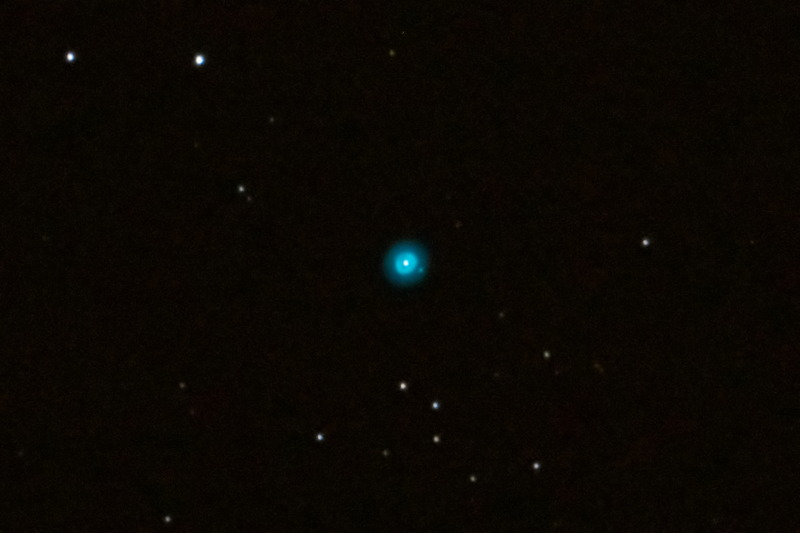
New Clock Failed; NGC185, NGC1535, & NGC281 (Pacman Nebula)
Posted: 14 January 2012
After the partly cloudy sky during my last observing session (10 January 2012), the sky turned overcast starting on Wednesday, 11 January. It stayed that way until Friday, 13 January, when the sky cleared. Opened the observatory at 1806 MST, 56°F. When I entered the observatory I noticed that my new digital clock was locked up:

I tried resetting it but nothing worked. I unplugged it from the AC power and plugged it back in. The display changed:

However, the clock was still locked and non-functional. I unplugged it and took it back to the house. I got the older clock and brought it back to the observatory, plugged it in, and set it. It worked fine (of course).
With the clock now replaced, at 1824 MST, viewed Venus, which displayed a bright gibbous phase at 77X. Then viewed Jupiter at 77X. Four moons were visible, with the transit of Io just ended. At 206X, Io's shadow was easily seen in transit at the central meridian. The Great Red Spot was just rotating into view. I then started preparations for the night's D7000 DSLR DSO imaging.
The first target was the Cassiopeia A supernova remnant. The camera was mounted at prime focus + Off-Axis Guider (OAG). I did 1 and 3 minute, ISO 6400, unguided exposures to see if the object could be captured. Nothing was visible on the D7000 screen and nothing appeared in the images during post-processing on the computer.
The next target was NGC185, a small faint galaxy that is a satellite of M31 (Great Andromeda Galaxy). This is a guided 5 minute, ISO 6400, prime focus image, cropped:

Saturation was decreased in the image during post-processing to bring out the dark areas in the galaxy. As with all DSO images in this report, I used Neat Image (see my review) to reduce the digital noise.
Next was NGC1535, a small faint planetary nebula. This is a 30 second, unguided, ISO 6400, prime focus image, cropped:

I then added the focal reducer and slewed to NGC281 (Pacman Nebula). I did several unguided and guided exposures trying to get good framing of this large DSO. I was finally satisfied with the framing and captured this 5 minute, ISO 6400, guided, uncropped image:

I returned to Cassiopeia A and did an unguided 5 minute, ISO 6400, prime focus + focal reducer, exposure, but again, nothing was visible in the image during post-processing.
I ended DSO imaging with the D7000 at 2110 MST and started a series of iPhone DSO test astrophotography for some software reviews I'm working on. I completed the tests at 2147 MST.
Viewed M42 (Great Nebula in Orion) with 26mm eyepiece + focal reducer. Lovely view. Removed the focal reducer, and at 2155 MST, viewed NGC2440, a small faint planetary nebula. The disk was small at 77X, but the view was much better at 206X. I plan to image NGC2440 on a future session.
Closed the observatory at 2217 MST, 48°F.
After I returned to the house, I plugged in the failed digital clock. It worked. I reset the time and calendar. Unlike a few days ago when I initially set up the clock indoors and in the observatory, this time the year selection worked correctly. I don't know if the problem with the year selection is related to the lockup or whether the low temperatures in the observatory caused the lockup. I will let the clock run indoors for awhile before taking it back to the observatory. Stay tuned.
Go to the previous report.
Return to the Cassiopeia Observatory Welcome Page.